What is an Outer Large Moon?
The moons of Saturn belong in different orbital groups. The moons in these groups generally share some common characteristics, may it be in appearance, composition, distance from the planet, or the effects they have on the moons, and/or the rings, near them. We can easily find the outer large moons because they are some of the most prominent members of the Saturnian system, and even the solar system as a whole. They lie beyond the E ring and are mostly composed of water ice. The four outer large moons of Saturn, based on distance from the parent planet, are Rhea, Titan, Hyperion, and Iapetus. For this post, we are going to be taking a deeper look at the Titan moon.
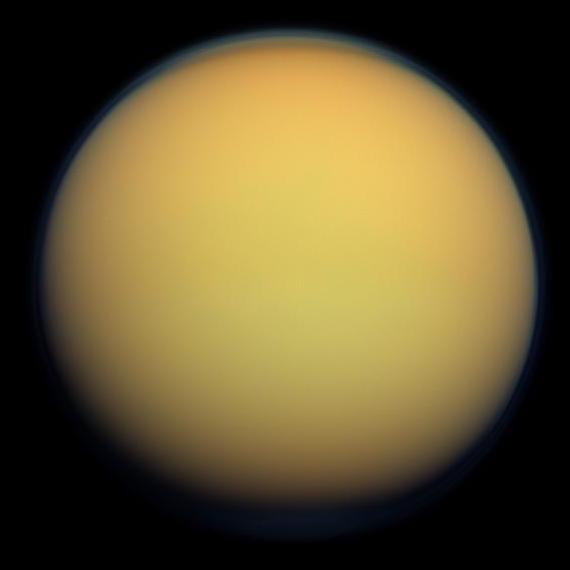
The Titan Moon
Titan Moon: Facts and Figures
All About the Name
- Pronunciation – /ˈtaɪtən/
- Behind the name – Tītan (The pre-Olympian gods in Greek mythology)
- Adjective/s – Titanian; Titanean
- Other designation/s – Saturn VI
Discovery Details
- Discoverer/s – Christiaan Huygens
- Discovery date – March 25, 1655
Orbital Characteristics
- Parent planet – Saturn
- Orbital period – 15.945 days
- Average orbit distance – 1 221 870 km
- Mean orbit velocity – 20,051.2 km/h (5.57 km/s)
- Eccentricity – 0.0288
- Orbital inclination – 0.34854° (to Saturn’s equator)
Physical Features
- Equatorial radius – 2 574.73 ± 0.09 km
- Equatorial circumference – 16,177.5 km
- Volume – 71,496,320,086 km3
- Moment of inertia factor – 0.3414±0.0005 (estimate)
- Mass – (1.3452±0.0002)×1023 kg
- Surface area – 83,305,418.53 km2
- Mean density – 1.8798 ± 0.0044 g/cm3
- Surface gravity – 1.354 m/s2
- Escape velocity – 9,507 km/h
- Rotation – Synchronous rotation
- Axial tilt – Zero
- Surface temperature – 93.7 K (−179.5 °C)
- Geometric albedo – 0.22
- Apparent magnitude – 8.2
- Atmosphere Surface Pressure – 146.7 kPa (1.45 atm)
Composed of
- Nitrogen (N2)
- Methane (CH4)
- Hydrogen (H2)
Titan is Saturn’s largest moon. Overall, it is the second-largest moon in our solar system, the biggest one being Jupiter’s moon Ganymede. Another designation for this giant moon is Saturn VI.
Titan holds lots of similarities to Earth. Aside from being the only moon with a dense atmosphere, its potential to hold life is even more probable because of the different bodies of water like rivers, lakes, and even seas on its surface.
Titan’s apparent magnitude is about 8.2. It can not be seen with the naked eye. The geometric albedo of this moon is 0.22. Being the biggest member, it is the first moon discovered in Saturn. Its mass, diameter, and density are comparable to those of the moons Ganymede and Callisto (the third-largest moon in the solar system).
Did You Know?
There was a time when Titan was thought to be the largest moon in the entire solar system. Scientists made this conclusion based on their ground observations of the moon.
However, in 1980, Voyager 1 revealed that the moon Ganymede of Jupiter is actually larger. The overestimation of Titan’s size was caused by its atmosphere.
It was so dense that it looked like it was a part of the moon’s surface, thus increasing its apparent size.
Titan has a dense and hazy atmosphere. It is likened to the atmosphere of Venus in the way that it is a “super rotator.” And with that, it means that the atmosphere moves faster than the surface of the moon.
Having a surface area of 83,305,418.53 km2, it is believed that Titan has a rocky center as observed by NASA’s Cassini spacecraft. This core is surrounded by distinct and differentiated layers of ice. Even at extremely low temperatures, water can remain in liquid form in the interior of this moon because of the presence of ammonia.
Many scientists believe that the conditions on Titan are comparable to the Earth’s characteristics in its early years. But of course, the moon’s temperature is much lower considering its great distance from the Sun.
Did You Know?
Sunlight takes approximately 80 minutes to reach the Titan moon.
How Did the Titan Moon Form?
The planets in the neighborhood of our solar system are a product of co-accretion. In this process, disks of diffuse material were in orbital motion around the Sun until they coalesced and became the planets.
The moons of the gas giants Jupiter and Saturn are believed to have also come from the process of co-accretion of material around them. However, the orbital eccentricity of Titan is just unusually high that its origin story may be different from the others.
A newer theory suggests that Titan may have resulted from impacts of pre-existing moons. These pre-existing moons experienced lots of giant impacts and collisions which gave way to the formation of new moons. The other two outer large satellites of Saturn, Rhea and Iapetus, are also said to have originated from the same events.
Discovery
 Dutch astronomer and physicist Christiaan Huygens discovered the moon Titan on March 25, 1655. It was the first natural satellite of Saturn ever discovered. It was also one of the earliest known moons in the solar system.
Dutch astronomer and physicist Christiaan Huygens discovered the moon Titan on March 25, 1655. It was the first natural satellite of Saturn ever discovered. It was also one of the earliest known moons in the solar system.
While our planet’s Moon has been known to us ever since, Titan became the sixth moon discovered after Jupiter’s four largest moons, Callisto, Europa, Ganymede, and Io.
Galileo Galilei was the one who discovered the largest moons of Jupiter. And in his honor, these four astronomical bodies are collectively called Jupiter’s Galilean moons.
Huygens took Galilei’s example and followed suit in his scientific endeavors. He studied the technology of the telescope and tried building them, together with Constantijn Huygens Jr., his older brother.
The effort made by the Huygens brothers soon paid off as they later discovered the moon, Titan. This led to the discovery of more and more Saturnian moons.
Visits to Titan
Observing the moon Titan had its challenges before the time of the Space Age and exploration.
Observers were only able to get a glimpse of it using telescopes. But the thing was, Saturn and its rings were so bright that they overpower Titan. They were able to find a solution to this by using an occulting bar, a strip used to block the bright objects from the eyepiece.
So far, three missions have visited the system of Saturn successfully. Pioneer 11, Voyager 1 and 2, and the Cassini-Huygens missions each provided important findings of Titan.
Many other future missions have been proposed to explore Titan more extensively. One of them is the Dragonfly mission. It is already approved and is set to launch in June 2027. It will use a rotorcraft that aims to focus and study the habitability aspects of the moon.
Pioneer 11
The earliest visit to Saturn took place in 1979 through Pioneer 11. The probe was able to snap some images of Titan’s surface, something that was obscured from ground observers before because of the moon’s hazy and thick atmosphere.
Findings from this mission suggested that life may be impossible on Titan because of its very cold temperature.
Voyager 1 and 2
The Voyager twin probes visited Titan in 1980 and 1981. Voyager 1’s flyby on Titan was responsible for uncovering the moon’s composition, mass, density, and temperature of its atmosphere.
Cassini-Huygens
The Cassini-Huygens mission arrived in the Saturnian system in 2014. It was a joint project by NASA, the Italian Space Agency (ASI), and the European Space Agency (ESA). The mission was managed by the Jet Propulsion Laboratory.
Lots of targeted and closed flybys were done by the Cassini spacecraft which aided in a better understanding of Titan. The mission was able to map the surface of the moon. It revealed numerous surface and geographic features such as lakes and seas.
The Huygens Probe
Huygens was a robotic space probe that was sent on an unprecedented mission with the Cassini orbiter. It remained mostly dormant during their journey towards Saturn.
On January 14, 2005, it landed on the surface of Titan and was the first man-made probe to ever do so. It landed on Titan’s eastern region called Adiri.
Huygens collected data on the atmosphere of Titan during its descent. It was also able to take images of the surface of the icy moon. Some geographical features include hills and rivers. It also has lots of pebbles scattered around which are made up of water ice.
Characteristics
Size
Saturn’s moon Titan lives up to its name. This gigantic moon is 5,149.46 kilometers or 3,199.73 miles across. It is about 1.5 times bigger than the Earth’s Moon, which is the fifth-largest moon in the solar system.
The moon Titan is even bigger than the planet Mercury whose diameter is 4,879 km (3 031.67 mi). That’s about 1.06 times as big! This moon is smaller than the Earth by about 2.5 times.
The equatorial circumference of Titan is 16,177.5 km. Its volume is 71,496,320,086 km3, which is about 0.066 Earths.
Mass
At 134,552,523,083,241,000,000,000 kg, Titan is as massive as 0.0225 Earths. It is also more massive than our Moon by about 1.829 times.
Density
The bulk density of Titan is 1.88 g/cm3.
Composition and Structure
Titan is similar to the other icy moons Enceladus and Dione in terms of composition. But because of a phenomenon called gravitational compression, it has a higher density.
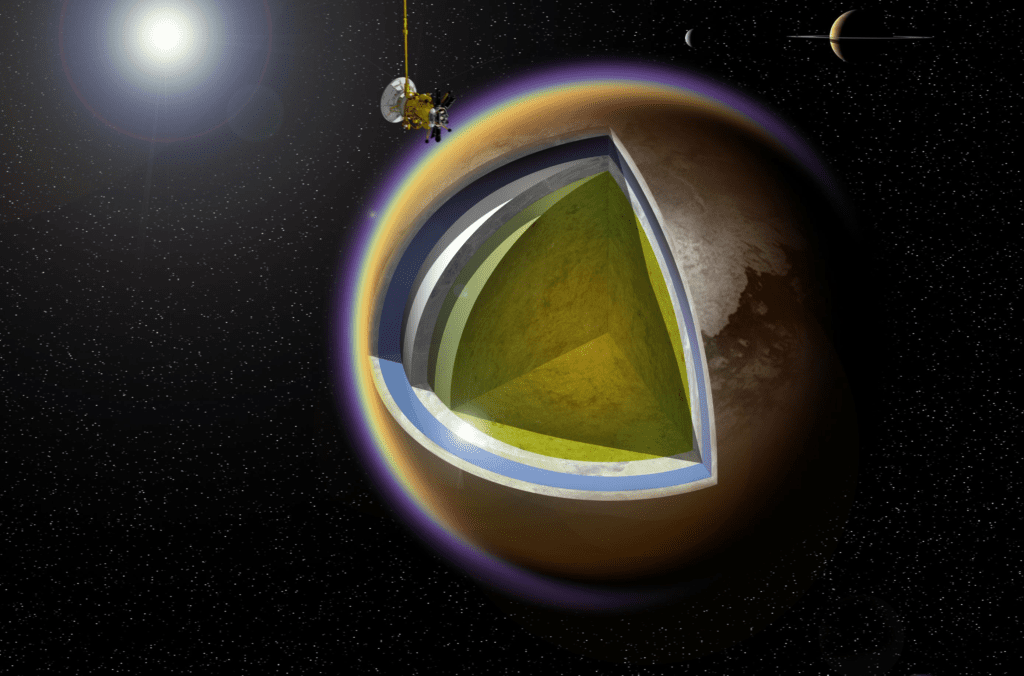
Findings from the Cassini orbiter suggest that Titan’s interior and crust are not homogenous. It has a rocky core that is surrounded by layers of ice and liquid.
Observations from October 2005 to May 2007 show that a shift happened on the surface features of the moon by about 30 kilometers. Another proof of the differentiated nature of TItan’s interior is the change in its gravity field as it journeyed around Saturn.
Orbit
The periapsis and apoapsis (collectively apsis) determine the nearest and the farthest point of Titan in its orbit around Saturn, respectively. The periapsis of this moon is 1 186 680 km while its farthest point, or apoapsis, is 1 257 060 km.
Titan’s average orbit distance to its parent planet is 1 221 870 km. It takes this icy moon nearly 16 days to complete a trip around Saturn.
Its calculated average orbital speed is 5.57 km/s with an orbital eccentricity of 0.0288. The orbital plane of Titan is inclined by 0.348 degrees in relation to the equator of Saturn.
Rotation
It takes the same time for Titan to rotate on its axis and to orbit the planet Saturn. It means that it is in a synchronous rotation with Saturn and is tidally locked to the planet.
By being tidally locked, only one side of this moon has the chance to face the planet. This relationship is very common between a natural satellite and its planet. In fact, our Moon is also tidally locked to the Earth.
Role
Titan is in a 3:4 orbital resonance with the moon Hyperion. Since it is much bigger, Titan is not affected as much as the irregularly shaped Hyperion.
Hyperion’s orbit is rather eccentric because of this resonance. Its rotation is affected as well. Because of this and its big distance from Saturn, it is one of the few moons in the solar system that is not tidally locked to its planet.
Did You Know?
The other known moons that are not in synchronous rotation with their planet are found in the system of Pluto.
These moons are Hydra, Kerberos, Nix, and Styx.
Temperature on Titan
The average surface temperature of Titan is approximately 94 K or −179.2 °C, far lower than the Earth’s. With that said, it is expected that there will be much difference between the two. It turns out, however, that Titan has its way of making up on things, making it very Earth-like in terms of many aspects.
The thick atmosphere of Titan acts like a double agent. A big percentage (about 90%) of the sunlight is absorbed by this moon’s atmosphere. In fact, Titan receives only 1% of the amount of sunlight that the Earth does.
Titan, however, has its own solution to its very cold surface temperature. The methane in its atmosphere comes into rescue and creates a greenhouse effect on the moon’s surface. It somehow keeps Titan’s surface hotter, and without it, it will be much colder.
The greenhouse effect on Titan is balanced in a way that it does not become too much. The haze in its atmosphere partially cancels sunlight from reaching the surface and, instead, redirects it into space. This way, the haze acts as an anti-greenhouse effect mechanism.
Seasons and Climate
The amount of sunlight that reaches Titan is significantly affected by its orbital tilt and the axial tilt and eccentricity of its host planet, Saturn. One year on Saturn equates to 29.5 years here on Earth while a day on Titan is about 16 days.
Titan receives different amounts of sunlight as Saturn orbits the Sun. This brings about changes in seasons, most especially in the moon’s northern and southern hemispheres. It includes differences in haze density, changes in the size of hydrocarbon lakes, and surface winds and cloud variations.
Clouds, Circulation, and Methane Rain
Clouds have been found over the north and south polar regions of Titan. The clouds are made up of simple organics, mostly methane and ethane. The cloud and rain activity on Titan is believed to be analogous to the water cycle of the Earth.
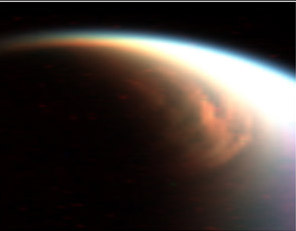
The atmosphere of Titan circulates in a Hadley cell. The warm air in its southern hemisphere rises and then sinks in the northern hemisphere. This kind of wind circulation results in what is like the Intertropical Convergence Zone (ITCZ) on Earth.
Rainbows can form on Titan because it experiences liquid methane rains periodically. These rains fill its lakes with hydrocarbons. The presence of these lakes is affected by the climate.
More methane lakes are visible around the north pole of Titan which is in winter and smaller numbers are observed near the south pole which is experiencing summer. This observation led to the hypothesis that methane rains occur during the winter season and evaporate during the summer.
Titan’s Atmosphere
Titan’s atmosphere is unlike any other natural satellite in the solar system. While the other moons have atmospheres that are close to none, Titan’s is dense and very rich in nitrogen. In fact, with a surface pressure of roughly 1.45 atm, it is even denser than our planet’s atmosphere!
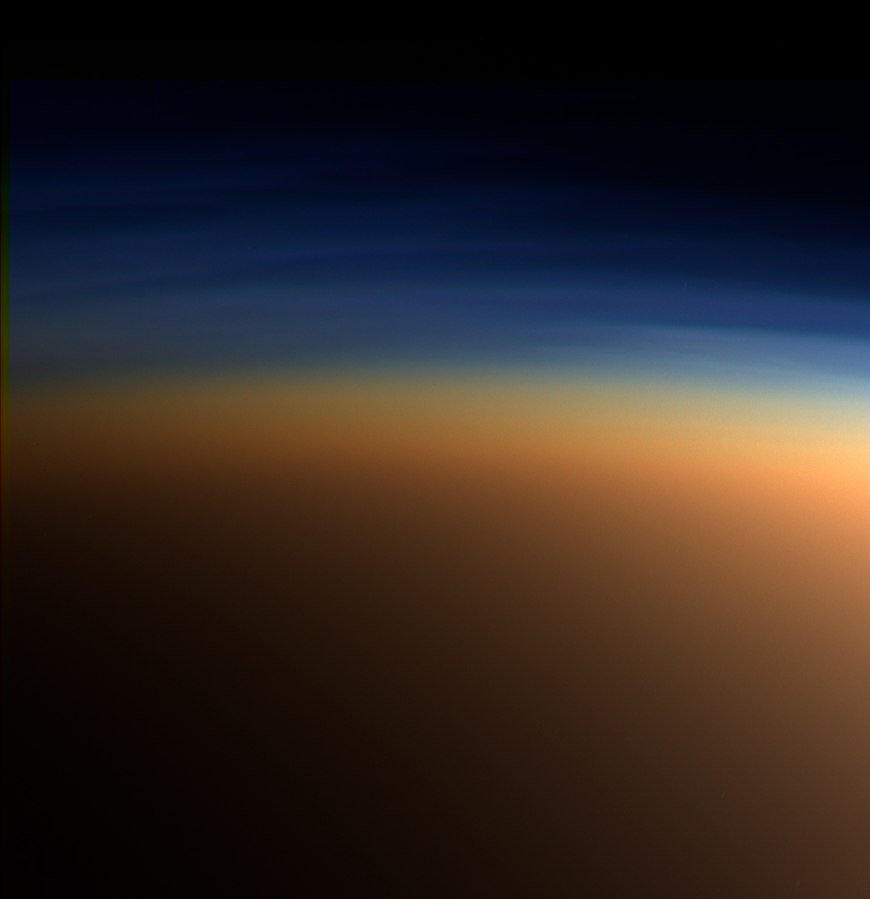
In terms of composition, Titan’s atmosphere is largely dominated by nitrogen, some amounts of methane and hydrogen, and a very low percentage of other gases and hydrocarbons.
Atmospheric Composition of Titan
- Nitrogen 97%
- Methane 2.7±0.1%
- Hydrogen 0.1–0.2%
In trace amounts
- Other Hydrocarbons – Ethane, Diacetylene, Methylacetylene, Acetylene, Propane
- Other Gases – Cyanoacetylene, Hydrogen cyanide, Carbon dioxide, Carbon monoxide, Cyanogen, Argon, Helium
The atmosphere of Titan is also more extended than that of our planet’s, considering its lower gravity. It is mostly opaque at many wavelengths and blocks most of the sunlight from reaching its surface. The dense atmosphere of Titan has a haze layer that lies about 200 km above the surface.
The orangey-brown smog that surrounds Titan is probably because of the methane breakup in its upper atmosphere. This breakup, or photolysis, is caused by the ultraviolet light of the Sun which converts methane into more complex hydrocarbons.
Though the process of methane breakup has been happening for a very long time, Titan’s methane supply has never run out. This led scientists to believe that the moon replenishes itself from the interior, probably through eruptions of cryovolcanoes.
Did You Know?
A study involving the nitrogen in the atmosphere of Titan suggests that the moon may have the same source as the material in the Oort cloud.
It supports the idea that this moon may have originated from impacts on pre-existing moons and not through co-accretion.
More and more elements that make up the hazy atmosphere of Titan are getting discovered. For instance, the presence of methane was found in the polar clouds of this moon in 2014.
Back in 2013, NASA studied the organic chemicals known as tholins in Titan. They were also able to identify the presence of propene in the atmosphere of this icy moon. So far, Titan is the only astronomical body in the solar system, other than Earth, where propene was found. Polycyclic aromatic hydrocarbons were also detected in the same year in Titan’s atmosphere.
What Does the Moon Titan Look Like?
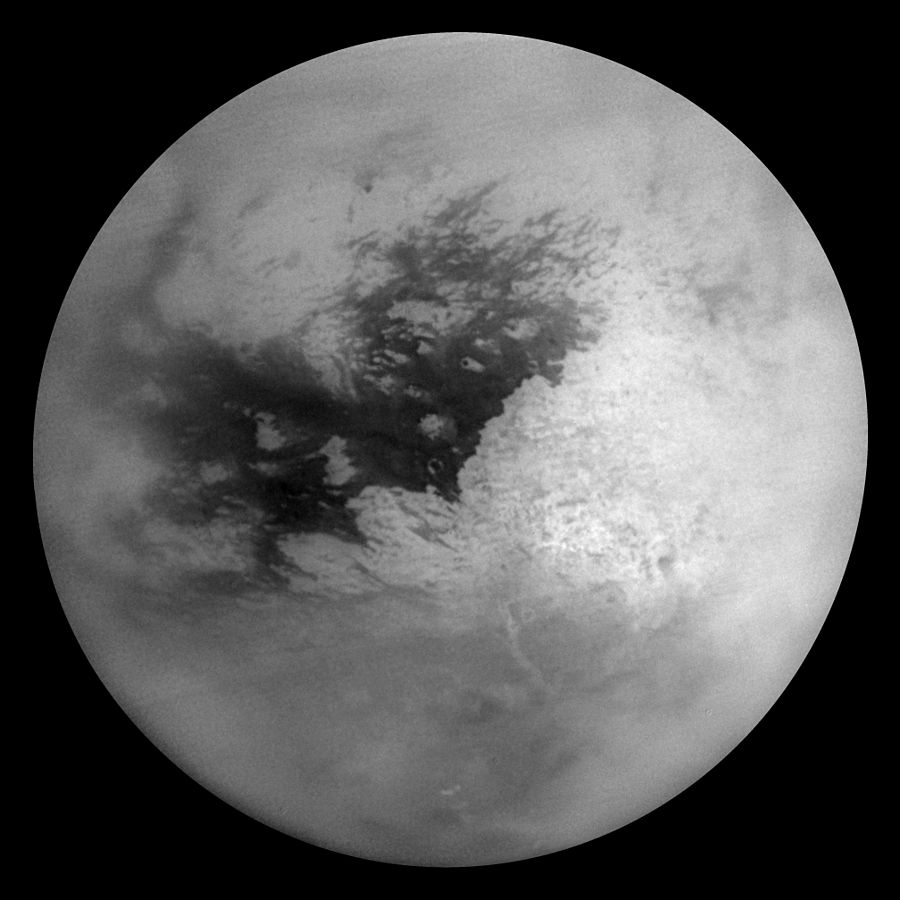
Because of the dense atmosphere of Titan, its surface features were mostly hidden for observation. Direct images of this moon’s surface were first captured in 2004 when the Cassini-Huygens mission arrived in the Saturnian system.
The topography of Titan is as diverse as the Earth. Though the presence of mountains was seen, they are only about 1 kilometer high at most, so the moon is generally flat. Astronomers believe that there may be cryovolcanic processes going on in Titan, which likely accounts for a big part of its atmosphere’s methane.
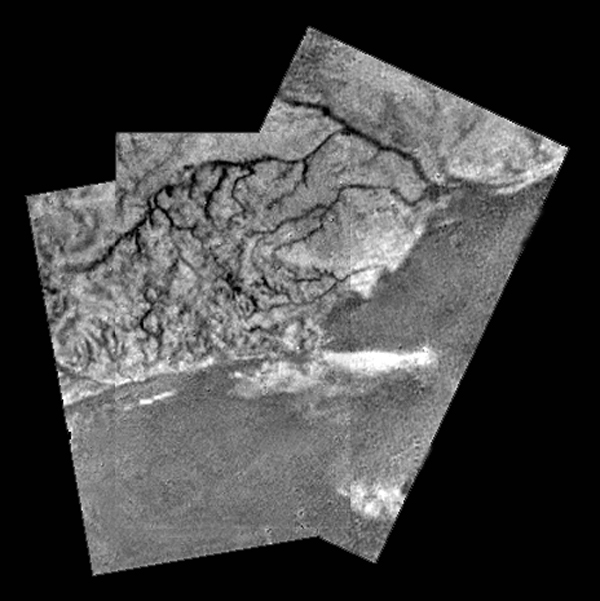 Hydrocarbon lakes discovered on the moon’s surface are associated with channel systems. These lakes are mostly located in the moon’s polar regions. Still, Titan is much drier than our planet and is mostly covered with dunes. These dunes, which look like coffee grounds, form a long and parallel appearance because they follow the wind direction.
Hydrocarbon lakes discovered on the moon’s surface are associated with channel systems. These lakes are mostly located in the moon’s polar regions. Still, Titan is much drier than our planet and is mostly covered with dunes. These dunes, which look like coffee grounds, form a long and parallel appearance because they follow the wind direction.
Ice rocks of different sizes are found on many parts of the Titanean surface. In general, Titan has fewer impact craters compared to the other moons of Saturn and is, more or less, smoother. This is because the craters have been mostly filled in by activities such as hydrocarbon rains.
Surface Features
Overall, the Titanean surface appears to be geologically young. A big part of this moon is characterized by its albedo features, two contrasting zones of bright and dark terrain.
The moon has many other features which are named and classified into different categories. There are more than 20 of these groups.
TYPES OF GEOLOGICAL FEATURES ON TITAN
Features (in plural)
Albedo Features
- Bright Albedo Features
- Dark Albedo Features – Surface regions that show contrast in terms of brightness and darkness
Arcūs – Arc-shaped features
Colles – Small and round hills or knobs
Craters – Circular depressions formed by impacts
Faculae – Bright spots
Fluctūs – Flow terrain
Flumina – River-like channels that are believed to be carved by liquid
Freta – A strait of liquid which connects two larger liquid bodies
Insulae – Islands in the seas of Titan
Labyrinthi – Intersecting ridges/ valleys
Lacunae – Features that look like dry lake beds
Lacūs – Hydrocarbon lakes
Large ringed feature – Mysterious ringed features
Maculae – Dark spots/areas on the surface
Maria – Hydrocarbon seas
Montes – Mountains
Planitiae – Low plains
Regiones – Regions that are distinct and different compared to their surroundings
Sinūs – Bays within bodies of liquid
Terrae – Extensive landmasses
Undae – Dune fields
Virgae – A streak/stripe of color.
Here are some of the most prominent geological features on Titan.
Xanadu
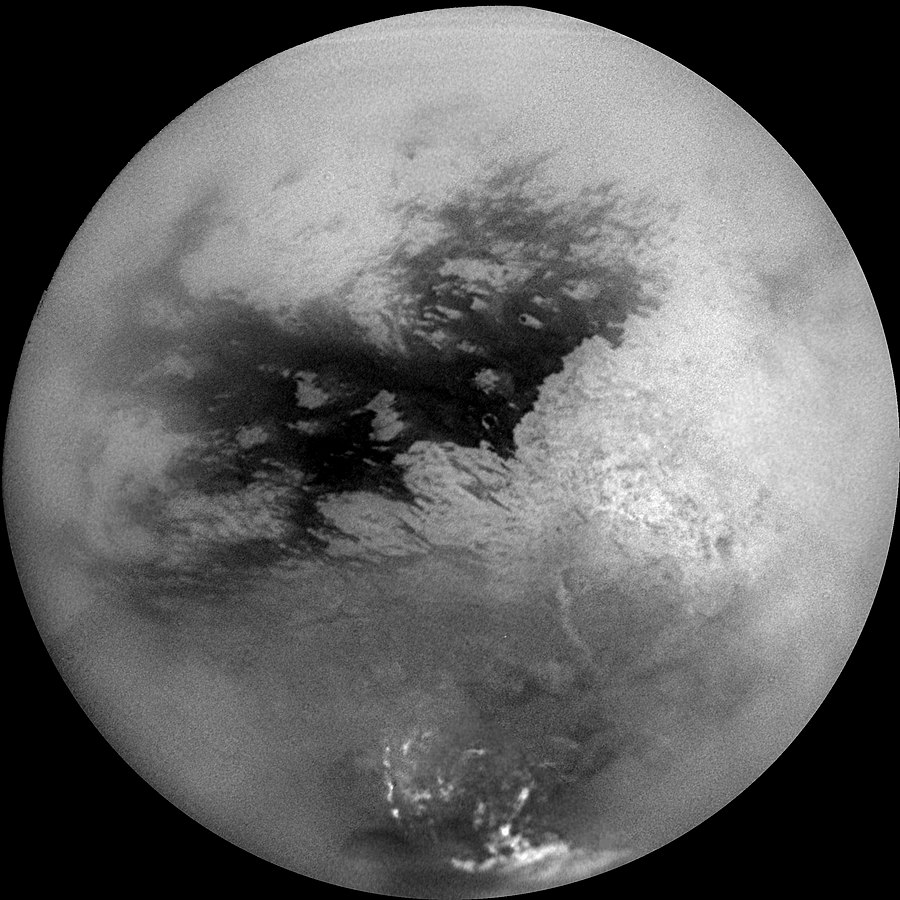
Xanadu is a bright albedo feature of Titan, seen at the bottom center of the photo above (the dark region in the center is Shangri-La). This highly reflective region, roughly as big as Australia, is likely made up of water ice. Many other surface features can be seen in the area such as rivers, hills, valleys, and dunes.
Shangri-La
Dark terrains and sand seas can be seen along the equatorial regions of Titan. Three of these major areas are Shangri-La, Fensal, and Belet.
Shangri-La is a dark albedo feature that is a vast sea and organic material. Much is still unknown about the origin and composition of its dark sand.
Ontario Lacus
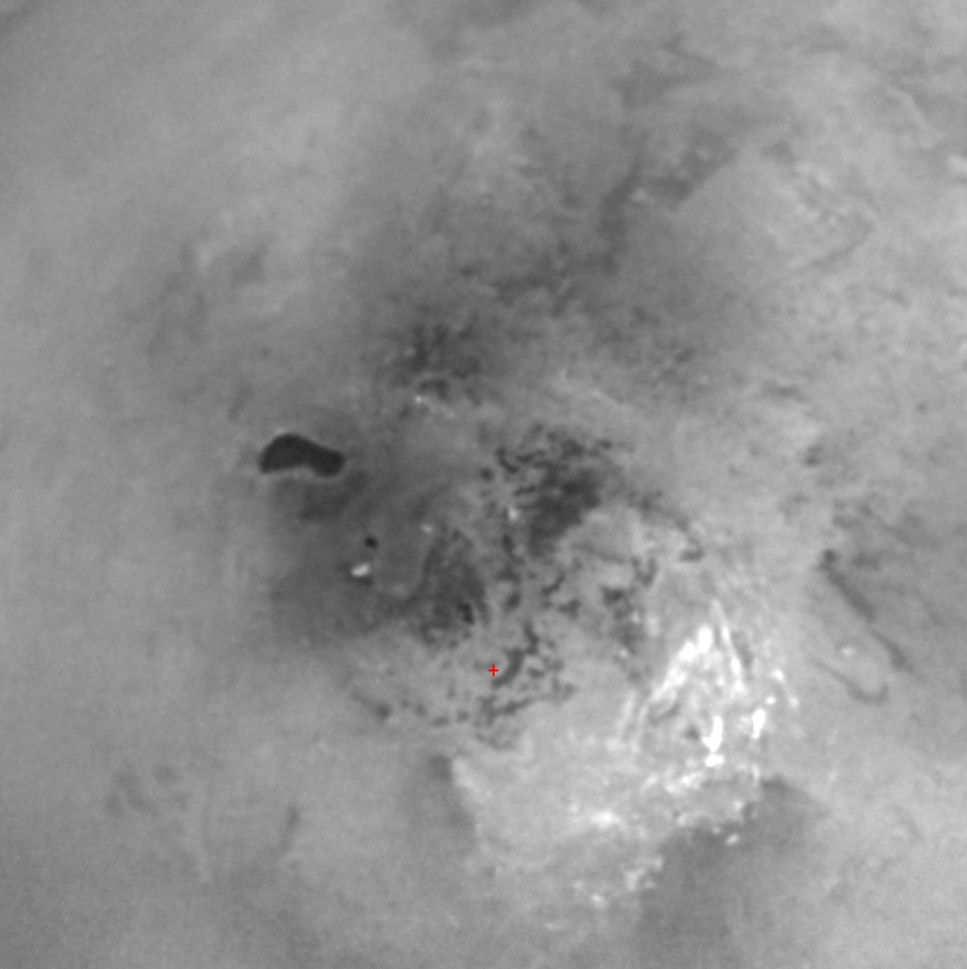
Ontario Lacus is a methane lake located in Titan’s south polar region. Its shoreline is shaped by its waves. Features such as hills and river valleys were observed near its northern shoreline. River deltas similar to some landforms here on Earth were formed in its western shoreline.
Another big lake, with a size similar to Ontario Lacus, is Jingpo Lacus. It is located near the north pole area of Titan.
Kraken Mare
Kraken Mare is Titan’s greatest body of water. This hydrocarbon sea is possibly larger than the Caspian Sea. Its depth is not yet fully determined but is estimated to be not less than 100 meters deep.
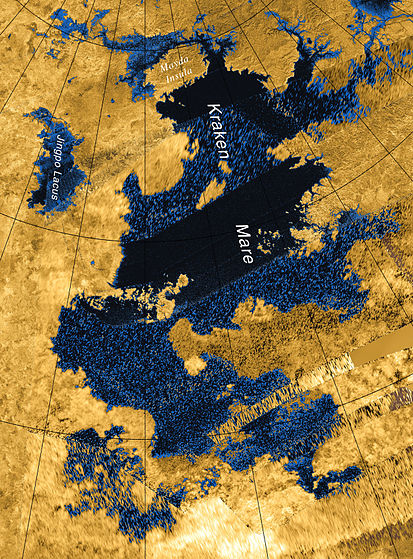
Kraken Mare is connected to Ligeia Mare, Titan’s second-largest sea. The tides and currents of this sea are probably the results of the moon’s orbital eccentricity.
Doom Mons
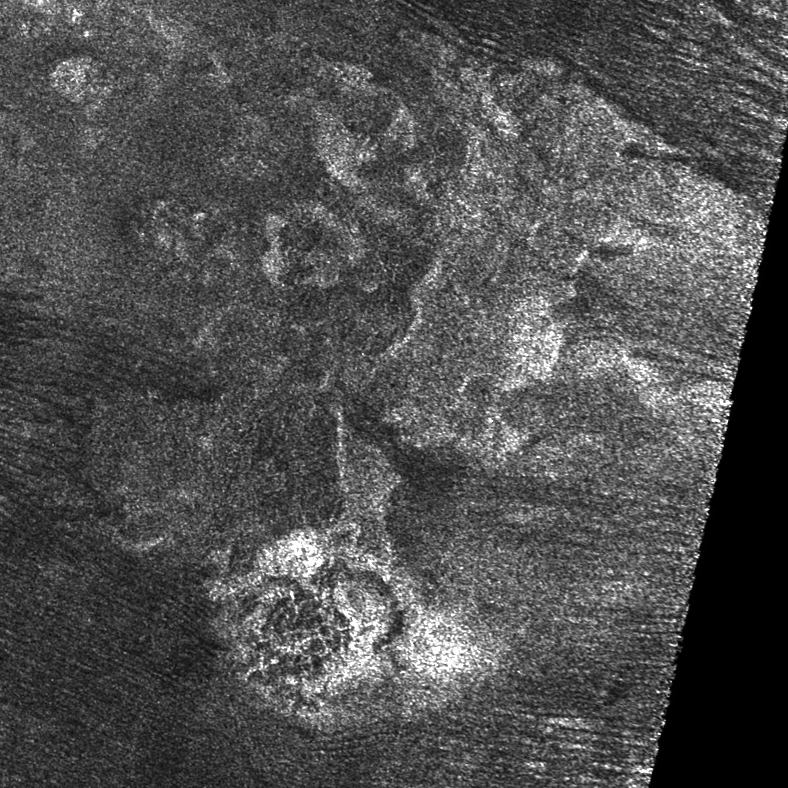
Doom Mons is the largest mountain range of the moon Titan and is generally considered a cryovolcano. It is located in a dark region in the southern part of the moon. Storms and similar activities constantly erode the mountains and keep them from getting taller. It is not the highest peak of Titan, though, as the title is held by Mithrim Montes.
Habitability and Potential for Life
Due to the presence of diverse organic compounds, Titan has long been considered a potential home for life. When energy such as UV radiation reacts with its atmosphere, complex organic molecules can be generated. It includes compounds that serve as building blocks of protein, as well as RNA and DNA.
Organisms are also likely to flourish in Titan’s subsurface water and methane lakes. However, the gases that they would inhale and exhale would be very different. Hypothetically, instead of oxygen, they would probably inhale hydrogen and exhale methane.
Also, the solvent that will be used among the life forms in Titan would not be liquid water, but probably liquid hydrocarbon.
Though Titan is, on many levels, similar to the primordial Earth, there are still a lot of obstacles in the chances of life on this moon. Some notable challenges include its extremely low temperature and the absence of water vapor.
The low temperature of Titan serves as one of the greatest blocks in the development of life. But in the far future, it may become hotter as the Sun ages and turn into a red giant. Water ice on this moon will likely turn into liquid form which would promote the formation of simple life forms.
The Sun is still halfway through its life as a main-sequence star, and it would not be until five billion years that it will enter the red giant stage. Even though we are yet to uncover life on Titan, its rich chemistry and prebiotic conditions provide scientists with great clues in better understanding the biosphere of our planet and the field of planetary science as a whole.
Behind the Name
After his discovery, Huygens called his discovery Saturni Luna. It means “Saturn’s moon” in Latin. It was also given a different Roman numeral designation back then when there were still five known moons of Saturn.
Astronomer Giovanni Domenico Cassini discovered four moons of Saturn after Huygens. These moons are Tethys, Dione, Rhea, and Iapetus. Unofficially, astronomers referred to them as Saturn I to Saturn V according to distance from the ringed planet. The moon Titan was in the fourth position at that time, being between the other two known moons Rhea and Iapetus.
Ultimately, other moons of Saturn were discovered, including those that lie between the first five. Official numbers were soon assigned and the International Astronomical Union (IAU) gave Titan the designation Saturn VI.
As for its permanent name, the convention of naming Saturn’s moons based on characters of Greek mythology was suggested by John Herschel.
The Titans of Greek Mythology
The Titans, in Greek mythology, were the rulers of the world before the Olympian gods. There were twelve of them, six males and six females. Their parents were the primordial deities Uranus, the Sky, and Gaia, also known as mother Earth.
Below is a simple family tree of these Greek characters:
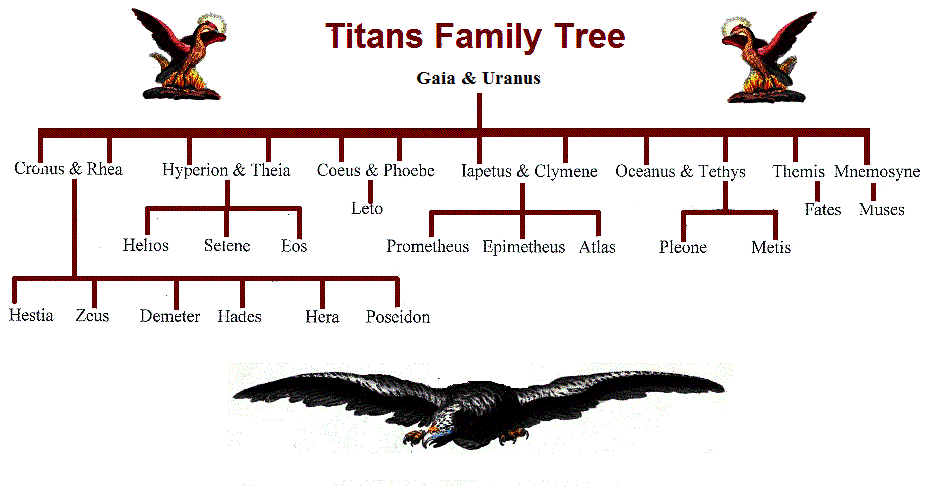
The male Titans became the consorts of their female counterparts, called the Titanides or the Titanesses. In the Greek succession myth, the Titans, led by Cronus, took over Uranus because he was a cruel father.
The Titans ruled and Cronus had children with his older sister, Rhea. They were Demeter, Hades, Hera, Hestia, Poseidon, and Zeus. And as if history just repeated itself, the newer generation of gods, led by Zeus, waged war against the Titans.
The Titans were overthrown and the principal gods of Mount Olympus rose into power.
Statistical Sources:
- https://en.wikipedia.org/wiki/Titan_(moon)
- https://solarsystem.nasa.gov/moons/saturn-moons/titan/by-the-numbers/
- https://solarsystem.nasa.gov/moons/saturn-moons/titan/in-depth/
- https://en.wikipedia.org/wiki/Climate_of_Titan
- https://en.wikipedia.org/wiki/Life_on_Titan
- https://www.odysseymagazine.com/what-does-tidally-locked-mean/
Image Sources:
- Titan moon: By NASA/JPL-Caltech/Space Science Institute – Public Domain, https://commons.wikimedia.org/w/index.php?curid=44822294
- Christiaan Huygens: By Caspar Netscher – Public Domain, https://commons.wikimedia.org/w/index.php?curid=44047
- Titan structure: https://solarsystem.nasa.gov/moons/saturn-moons/titan/in-depth/#otp_structure
- Cloud system of Titan’s north pole: By NASA/JPL/University of Arizona – Public Domain, https://commons.wikimedia.org/w/index.php?curid=9569659
- Titan’s atmosphere: Public Domain, https://commons.wikimedia.org/w/index.php?curid=293790
- Titan (what it looks like): By NASA/JPL/Space Science Institute – Public Domain, https://commons.wikimedia.org/w/index.php?curid=6983094
- Titan channel system: By NASA – Public Domain, https://commons.wikimedia.org/w/index.php?curid=43634962
- Xanadu: By NASA/JPL/Space Science Institute -Public Domain, https://commons.wikimedia.org/w/index.php?curid=43808
- Ontario Lacus: By NASA/JPL/Space Science Institute – Public Domain, https://commons.wikimedia.org/w/index.php?curid=43808
- Kraken Mare: By NASA/JPL/Space Science Institute – Public Domain, https://commons.wikimedia.org/w/index.php?curid=43808
- Doom Mons: By NASA/JPL/Space Science Institute – Public Domain, https://commons.wikimedia.org/w/index.php?curid=43808
- Titans family tree: http://www.talesbeyondbelief.com/myth-stories/cronus.htm